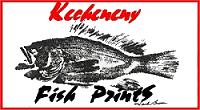
GYOTAKU - Creating Kecheneny Fish Rubbings
The process of fish rubbing starts with a fish. As Jack lives on the shoreline of the Northern Atlantic, getting these fish (his subjects) is no problem. He fishes quite extensively, as does his son, other family members and a great number of his friends, many of which own ocean going sport fishing boats and draggers. When Jack needs a certain kind of fish, he simply puts the word out. Often, he even specifies the size range, such as 14” to 16”. That’s a nice size fish to work with. When it came to the stripers, he needed one not much larger than the legal size of 28”. Any larger fish wouldn’t have fit on his paper.
Soon, Jack’s phone rings and the caller checks in with him from out on the high seas. He tells Jack what kind of fish he has and what its size is. Jack gives his “OK”, and is told what time to meet the boat at the dock.
The fish is washed and all slime is removed. Further preparation takes place, and the fish is thoroughly wiped down. The work table is setup and tools are set in place. Several pieces of paper are cut to length for this particular fish. The paper and the ink he uses are imported from Japan. It is now time to make the rubbing. Although many rubbings are made within three to four hour sessions, no more than six or seven prints will be deemed good ones and saved. A great many more will be discarded. And, he admits …. While they may look very nice in every respect, none are ever “PERFECT”.

The “Nice One” is set aside to be the master should he ever select this fish rubbing for a limited edition printing. The next “Nice One” is placed in a folder containing masters for the Kecheneny note card series. The remaining rubbings, often no more than four, are the ones available for purchase.
When the rubbing session is finished, the ink is washed away and the fish is cleaned. Some fish end up in Jack’s frying pan while others end up in his daughter’s “fish chowder”. The remains, along with inedible parts, end up in friends lobster pots as bait or in the garden as fertilizer. Nothing is wasted.
Because all fish have differently textured skin, some produce very nice rubbings with extremely visible scale patterns. Fish such as Porgy, Black Sea Bass, Striper, and Shad produce nice rubbings. Fresh water fish such as the Bluegill, Perch, and Bass also produce very nice rubbings. Fish with nearly smooth bodies and those with small scales such as schooling fish are much more difficult to work with. These include the salt water Blackfish and the Butterfish. With fresh water fish the Pickerel, and most notably the Trout, fall into this category. It is because of the skin texture that you will see a noticeably different image when looking at several different fish. It’s often the texture of the fish’s skin and not necessarily the experience or knowledge of the person making the rubbing that makes the difference.
While a great many species of fish are present in local waters all summer long and late into the fall, a few are not. The American Shad, White Perch, and the Alewife are some of the most notable. These fish return to fresh water each spring to spawn. They arrive in late April, remain for a very short time, and return to the ocean. It is during this time that one must know where to find them and how to catch them. For Jack, this meant getting up at the crack of dawn and driving to his favorite fishing hole for days and weeks on end, in pursuit of his “subjects”. Fishing along the banks with other anglers, Jack looks upon himself as a step above all the others. They are just “fishing” as he sees it, but as for him, he’s “working’.
In time, he will go about the task of selecting the rubbings for his next “Limited Edition” printing. Until that time, he will continue looking for additional “subjects” to add to his Kecheneny fish print collection.
The next time you see someone fishing,
you might stop and ask them … ya “KECHEN .. ENY”?

|
Home Page www.kechenenyfishprints.com |